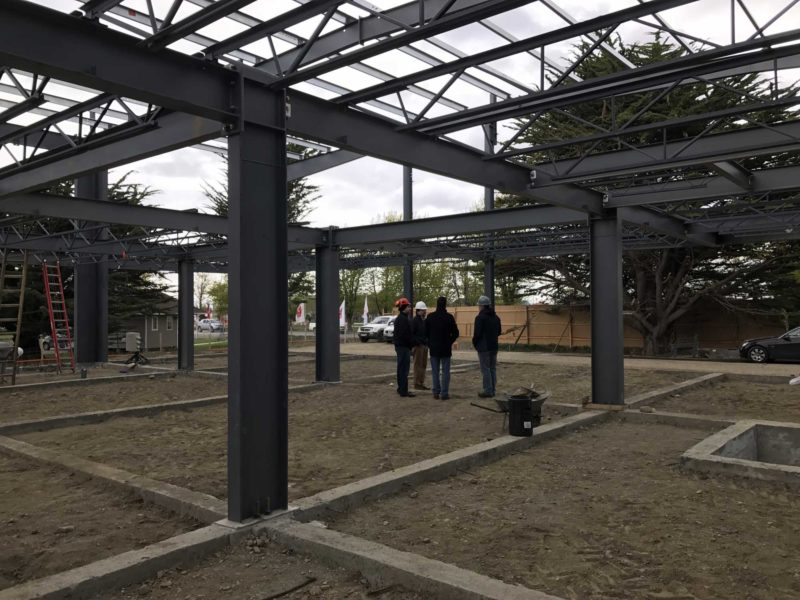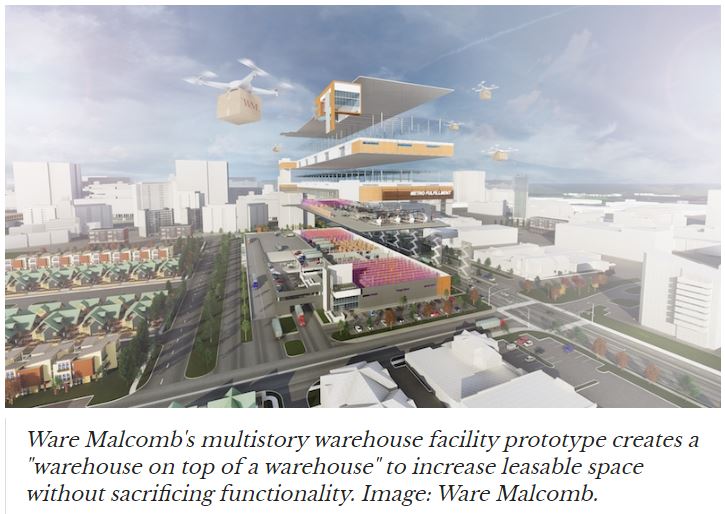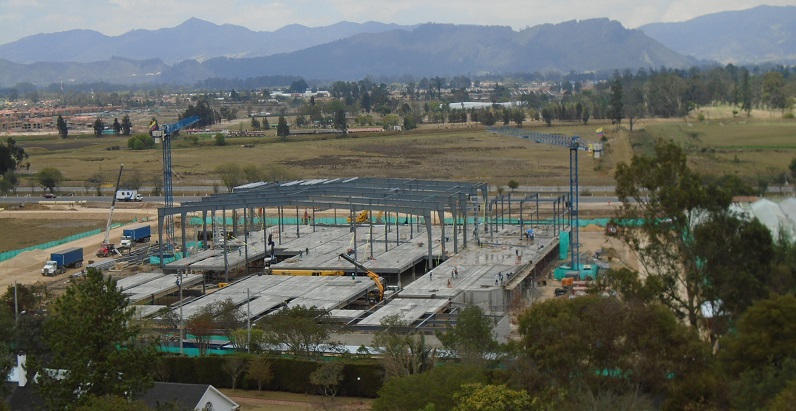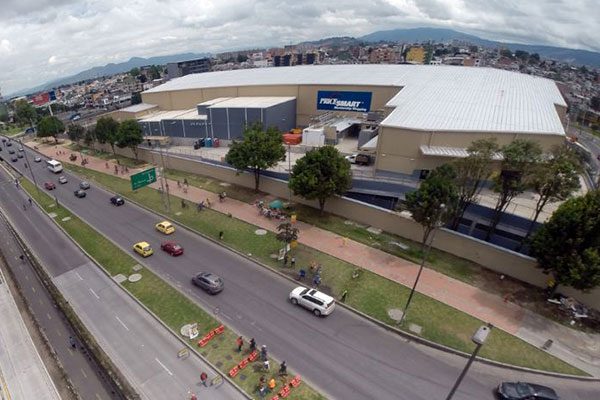Technology and e-commerce push industries to evolve at an exponential rate. Businesses are more focused on integrating work space activities, including manufacturing, design, showroom, and distribution activities.
Population and employment has exploded in the Metropolitan Vancouver area during the post-war era. It is projected to continue growing in the decades to come, with over 1,000,000 people and around 600,000 new jobs by the year 2040.
This level of growth will be tough to accommodate given the constraints of the Metro Vancouver area, as their expansion abilities are severely limited. Some protection was introduced under the Metro 2040 plan for the remaining land that is still left.
A constrained supply of land can be transformed into innovative multistory industrial buildings. Metro 2040 has included requirements for all municipalities to develop policies as well as encourage better intensification and utilization of industrial areas for industrial use.
Companies are currently dealing with population and economic growth, increased demand for space, and land supply constraints. Industrial land intensification opportunities including multistory industrial facilities, commonly referred to as “stacked” or “vertical,” are driving these current trends and challenging existing planning regulations all at the same time.

Multistory Steel Building
Industrial properties are no longer housed inside of single-story buildings on the fringe of an urban community. New kinds of industrial land intensification, including industrial real-estate, commercial real-estate, steel buildings, multilevel buildings, and other multistory structures, offer additional space for businesses to boost and expand employment growth opportunities within communities.
In Vancouver, industrial land developers, tenants, investors, elected officials, and planners realize how important industrial lands are to promote the area’s overall sustainable development. In order for a region to remain prosperous, a diversified, sustainable economy is necessary, and an adequate land supply is required to accommodate businesses in the long-term.
In this article we will discuss:
- Industrial Land Depletion
- What Is Industrial Intensification?
- Industrial Land Usage Can Be Described In Two Different Ways
- Evolving Industrial Activities
- Building Up: Challenges
- Considerations For Municipal Policies And Plans
- Considerations For The Future
- NAIOP Vancouver Involvement
- International Best Practices
Industrial Land Depletion
To illustrate the depletion of industrial land inventory in proportion to the current demand for land, there are two different scenarios to take into consideration: an increase proportional to current industrial development, and increased land demand due to “High Case” growth in trade activities along Vancouver’s ports.
Under the first scenario for proportional growth, by 2021, industrial demand would require 900 additional hectares and 700 more hectares by 2031 without intensification.
Under the second scenario for Base Plus High Case Export/Import Growth, by 2021, the demand for industrial land would require 1,400 additional hectares and 1,100 more hectares by 2031.
If industrial land is used more efficiently, the effective capacity of the land could be greatly extended.
What Is Industrial Intensification?
Industrial intensification, by definition, refers to increased productivity within an industrial property or greater use of the structure. Examples include additional shift workers, distribution centers containing high ceilings with racking, investments to automation, or other multilevel structures in urban areas.
The main objective of industrial land use intensification is to make sure that the limited available land space in Vancouver, and other regions, is used efficiently and productively. In order to achieve this goal and ensure that guidelines aren’t putting one industrial sector or sub-region at a disadvantage, the best approach is to use more than one measure of intensification to level the playing field.
Differences in intensification potentially exist in most industrial sectors. The types of businesses that are occupying the space have a variety of different operational requirements, and what any industry or business demands from a building or site can significantly vary. Boosting industrial intensity is different for each user or industry, which is why policy makers in Vancouver have been arguing that specific targets and measures of intensity must be developed for all industrial sub-sectors.

Industrial Land Usage Can Be Described In Two Different Ways
Intensity
Intensity is the volume of activity which can be measured by the number of jobs per land area or building, or the amount of goods being processed or produced per unit.
Density refers to the amount of space inside of a building including building volumes and heights, site coverage, or floor area ratio. Higher densities are usually correlated with higher intensities, but not always. One exception includes land-intensive industrial buildings or commercial property with high throughput activity that doesn’t necessitate a large structure, like a lumber mill. These activities require land for outdoor material and equipment for storage, vehicle parking, and truck loading.
Intensification: Drivers and Benefits
Multistory industrial structures are common in East Asia. Companies have either had to fulfill or build up their space requirements due to lack of affordable land. In order for these types of structures to be viable, however, land values must be high enough to justify the added development costs.
There are only a few multilevel structures in North America, but more projects are taking shape in places with expensive land values such as New York, San Francisco, Seattle, and New York.
Metro Vancouver, for instance, has the largest port in Canada and a population of over 2.5 million. Industrial land space has shrunk considerably in the region, manifesting itself in a variety of ways, including low vacancy and rental rates, and rising land prices that are the highest in North America. A study from Colliers International from the third quarter of 2019 showed that, for the 10th consecutive quarter, the industrial vacancy rate for Vancouver was below 2%. Currently, the average triple net rent has gone up 25% over the last two years. The forces that are propelling supply-and-demand are stimulating dense and intense forms of industrial expansion, such as multistory industrial facilities.
Numerous benefits for the community and the industry in jurisdictions with constrained land bases are feasible with industrial intensification such as: using resources more efficiently, reducing pressures on land development in the region, and conversions from agricultural to industrial.
Creating additional industrial space and increasing capacity for industrial use by constructing multilevel industrial structures is becoming more difficult, as industrial land use becomes harder to find.
Co-locating or clustering associated operations supports circular-economy systems and eco-industrial networks. Companies use these innovative complexes to share resources, such as peer-to-peer lending or to use each other’s by-products (e.g. material loops) in order to boost efficiency.
This will become important and inevitable in the long term given the limited amount of land that is left.
Evolving Industrial Activities
Industrial and accessory uses are becoming more diverse and evolving rapidly. Some uses necessitate new and different kinds of spaces.
Some commercial activities do not neatly fit within traditional industrial concepts of “light” or “heavy” and can range from creative/media/design, advanced technology, the emerging e-commerce sector, industrial assembly/fabrication in flex space units, local “maker movement” craftsmanship, laboratories, workshops, equipment maintenance, food processing, manufacturing and warehousing in small-scale operations (parts suppliers) or large one-user buildings, and conventional distribution.
Industrial areas may contain commercial or accessory activities that are related to or support primary industrial use. They can also provide local employees with amenities. If too much retail or office space is allowed, established industrial uses could either be displaced or become destabilized by increasing property rents, taxes, and land costs, and introduce conflicts regarding land use.
Building Up: Challenges
Multistory industrial facilities, compared with conventional single-level buildings, are more expensive to build and more complex to design. Underground parking facilities are often required, along with elevators and access stairs. Functional structural features for industrial occupants include load-bearing floors, specific requirements for column spacing and ceiling heights, specific widths for corridors, truck ramps or cargo elevators, and loading bays. Structured parking facilities and multilevel buildings reduce net usable areas by introducing additional structures such as vehicle ramps, which aren’t used in typical single-level industrial structures with surface parking, in addition to hallways, elevators, and stairs.

Multistory Steel Building Warehouse
In order for the projects to become financially viable, the additional costs will require higher rents. Higher-density industrial developments may be required in some cases including commercial or accessory uses related to the main tenant of the building who could cross-subsidize the entire cost of the structure. In Canada, for instance, current multilevel industrial projects are associated with stratification tenure. Similar to a condominium, units are owned instead of leased. These developments are financed through the pre-sales of new units.
In certain circumstances, density is limited by functional and regulatory requirements for loading, setbacks, and parking.
Considerations For Municipal Policies And Plans
Multilevel industrial expansion of commercial property has followed international trends toward densification and intensification, and generated additional industrial capacity. Intensification also benefits the community through jobs and an increased tax base which can spur economic growth.
Businesses across more cities in North America are evolving and adopting employment, economic, and industrial strategies to remove barriers and advance new opportunities. Regulations can permit new business types and models through a primary policy consideration. These new industrial forms should also be recognized by municipalities while established uses are left intact.

Multistory Steel Building Warehouse
In order to increase industrial expansion when reviewing land-use policies, municipalities should attempt to remove outdated intensification/densification barriers by considering the following:
Acceptable Industrial Uses
New industrial uses that don’t appear in current industrial zoning bylaws such as integrated work spaces, last-mile delivery, and e-commerce should be added.
Non-Industrial Uses
Any non-industrial uses should be restricted to an accessory scale that only supports primary industrial operations.
Density Restrictions
Density caps including height limits and building setbacks, as well as site coverage maximums, and floor area ratio should be adjusted accordingly.
Parking Requirements
Minimum parking in urban areas and locations located near mass-transit areas should be reduced.
Government agencies are concerned that some commercial real-estate construction sites will not be used as intended. Business licensing and occupancy permitting should be enforced by municipalities to secure the premise’s industrial use beyond the defined zoning use.
Considerations For The Future
One important part of a regional economy is industrial real-estate development. While there will be some land-intensive uses, multilevel buildings are becoming the wave of the future, and municipal regulations and plans should educate market forces by responding to industrial needs while keeping other community objectives in mind. Moving forward, the ramifications lie in balancing responsive regulations, business needs, development viability, and industrial trends along with other interests of the community. Industrial uses are intensified through challenge and opportunity without losing the land’s industrial functions.
NAIOP Vancouver Involvement
In order to coordinate planning with a limited land base, the planning authority in Vancouver will address these issues and explore policy actions and options such as industrial intensification in a regional industrial lands strategy.
The Intensive Use of Industrial Lands Committee is sponsored by NAIOP Vancouver. They will be exploring how intensification can be promoted. Three different land types are recognized by the organization, including rental housing through multilevel urban rental properties, multilevel industrial urban properties, and multilevel manufacturing/logistics.
In June 2019, NAIOP Vancouver organized a panel event as part of this initiative to discuss the trends that have been affecting the utilization of industrial lands, along with the possibility for intensification.
Some of NAIOP Vancouver’s key areas of focus include:
• Identifying municipal policies required to facilitate and enable intensification
• Economic viability of intensification
• Strategies to better utilize the limited supply of industrial land available
• Assessing the appetite for multilevel facilities from the industrial companies’ points of view
• Reviewing best-practices in other municipalities
International Best Practices
Non-industrial businesses are encroaching upon all jurisdictions that are currently facing industrial land supply shortages. Of particular concern is accessory and office use, as they can both destabilize land prices and push true industrial users out of the landscape. Some industries are being forced out due to high land prices in many city-regions. Vancouver is currently experiencing this phenomenon, as every jurisdiction attempts to control the amount of accessory and office use allowed in order to mitigate this problem.
Industrial land use studies, plans, and strategies in several cities outside of Vancouver were recently examined.
These cities all have different governance systems, transportation networks, land-use pressures from non-industrial activities, development patterns, and histories. In addition, there are differing definitions and visions of industrial intensification. Jurisdictions vary regarding the detail and focus of these plans. Industrial land protection is more common in cities where there are land scarcities.
Land use and building requirements are changed often to adapt to shifting economies. One such example is Hong Kong. Their industrial activities moved into China’s mainland, which allowed industrial building adaptions into commercial and office spaces.
Singapore has a top-down control approach to development. Intensification efforts are being implemented through their government to make land more efficient and productive.
In London, mixed-use developments with high density are currently being facilitated – more specifically, they are focused on keeping industries stacked vertically. They recently developed a matrix which identifies compatible, suitable uses for vertical intensification.
The Port of Rotterdam in the Netherlands is focused on clustering and maintaining efficient land use for their own intensification purposes.
In San Francisco, high prices along with a limited supply of land, have resulted in a loss of numerous industries in other parts of the area, including lower-cost municipalities. Several other cities in North America are also reviewing large inventories of dated industrial buildings in an attempt to convert them into modern industrial structures rather than using them for non-industrial purposes.
In two American cities, unique steps are being taken to embody industrial land intensification. In Seattle, pilot project sites are being tested in areas where policies that encourage intensification could be implemented. In Portland, an Industrial Land Supply Analysis was conducted in 2012, including a discussion of measuring efficient industrial land usage. Tonnage of cargo and added value were two alternative measures suggested in the study that would relieve pressure and support protection from other commercial uses and boost output efficiency.
High maximum Floor Area Ratios, or FARs, are allowed in North American zoning jurisdictions. Actual FARs, however, reflect the overall market and financial demand, which is why they are significantly lower.
Other uses in industrial areas, including extra office space can create some tensions. Ancillary office use for industrial activities is specified under zoning regulations, but size restrictions vary. In certain cases, large amounts of non-industrial activity are allowed in zoning bylaws, which potentially drives industrial users away.
Compared to the Metropolitan Vancouver area, most industrial land densities and intensities are relatively low in most jurisdictions of North America. All jurisdictions in Vancouver are being pressured to convert industrial land to other uses.
Instead of focusing on intensification, jurisdictions are focusing primarily on protecting industrial land supplies and addressing industry declines.
Some new examples of multi-level or higher density industrial developments have shown up in North America. New higher density construction includes a significant amount of office space or other non-industrial elements. Older multi-level steel buildings were built under entirely different conditions many years ago. Today, a lot of these buildings have been repurposed for non-industrial uses. Single-level buildings are generally preferred in the modern industry for practical purposes and require easy access and a good location.
Asia has an extremely limited land base as well as a growing economy and population. They also have a strong government agency. Multi-level industrial structures are being built for some sectors, while in Europe, some older multi-level historical structures are either being repurposed or are still currently being used for industrial purposes.
Original article published by naiop.org, “From Horizontal to Vertical Industrial Intensification Grows Up”.

